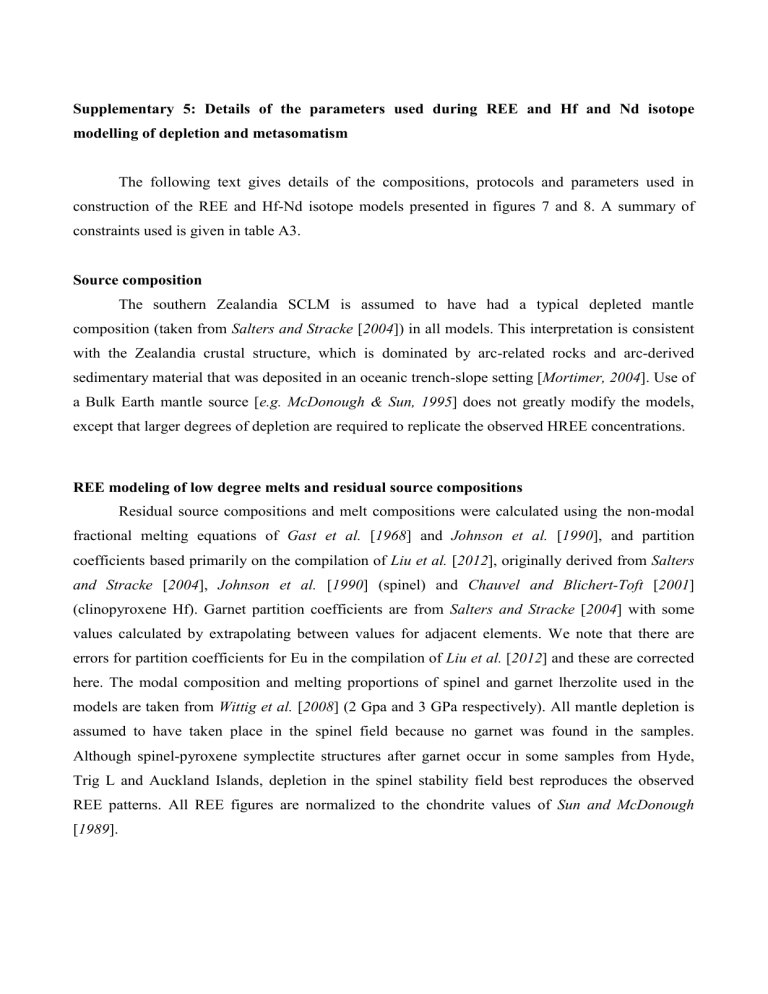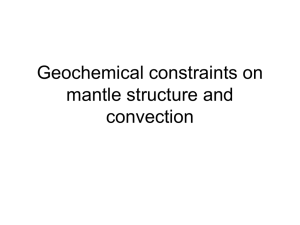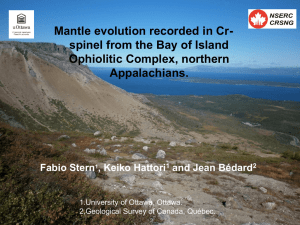ggge20547-sup-0006-suppinfo05

Supplementary 5: Details of the parameters used during REE and Hf and Nd isotope modelling of depletion and metasomatism
The following text gives details of the compositions, protocols and parameters used in construction of the REE and Hf-Nd isotope models presented in figures 7 and 8. A summary of constraints used is given in table A3.
Source composition
The southern Zealandia SCLM is assumed to have had a typical depleted mantle composition (taken from Salters and Stracke [ 2004 ]) in all models. This interpretation is consistent with the Zealandia crustal structure, which is dominated by arc-related rocks and arc-derived sedimentary material that was deposited in an oceanic trench-slope setting [ Mortimer, 2004 ]. Use of a Bulk Earth mantle source [ e.g. McDonough & Sun, 1995 ] does not greatly modify the models, except that larger degrees of depletion are required to replicate the observed HREE concentrations.
REE modeling of low degree melts and residual source compositions
Residual source compositions and melt compositions were calculated using the non-modal fractional melting equations of Gast et al. [ 1968 ] and Johnson et al. [ 1990 ], and partition coefficients based primarily on the compilation of Liu et al. [ 2012 ], originally derived from Salters and Stracke [ 2004 ], Johnson et al. [ 1990 ] (spinel) and Chauvel and Blichert-Toft [ 2001 ]
(clinopyroxene Hf). Garnet partition coefficients are from Salters and Stracke [ 2004 ] with some values calculated by extrapolating between values for adjacent elements. We note that there are errors for partition coefficients for Eu in the compilation of Liu et al. [ 2012 ] and these are corrected here. The modal composition and melting proportions of spinel and garnet lherzolite used in the models are taken from Wittig et al.
[ 2008 ] (2 Gpa and 3 GPa respectively). All mantle depletion is assumed to have taken place in the spinel field because no garnet was found in the samples.
Although spinel-pyroxene symplectite structures after garnet occur in some samples from Hyde,
Trig L and Auckland Islands, depletion in the spinel stability field best reproduces the observed
REE patterns. All REE figures are normalized to the chondrite values of Sun and McDonough
[ 1989 ].
Metasomatic components
Several different metasomatic components are used in REE models and values are listed in table A3. Various low-degree (0.2-3%) silicate melts of depleted mantle sources in the spinel and garnet facies are calculated using the methods, partition coefficients, modes and melting proportions described above (see table A3). To model the effect of carbonatitic metasomatism, compositions of contemporaneous carbonatites from the Alpine Dike Swarm in West Otago are used (INAA data from Cooper and Paterson [ 2008 ]) as well as the average carbonatite compositions presented by
Bizimis et al.
[ 2003 ].
REE models of depletion and subsequent metasomatism
Whole rock compositions of depleted mantle residues affected by metasomatism were modelled using bulk mixing between depleted residues and various metasomatic components described above. These modeled compositions were compared on a trial and error basis with whole rock compositions in equilibrium with the measured clinopyroxene trace element compositions calculated using the equation (rearranged from Liu et al. [ 2012 ] data supplement eq 4):
𝑊𝑅 𝑖
=
𝑋𝐶𝑝𝑥 𝑖
× 𝐷 𝑖
𝐾
𝐷𝑖
𝐶𝑝𝑥
Where i is the element of interest, XCpx i is the measured concentration of that element in the clinopyroxene, K
Di
Cpx is the relevant partition coefficient (see table A3) and D i
is the bulk partition coefficient calculated using modal compositions presented in table 1.
Modeling of Hf and Nd isotope composition of depleted and metasomatised peridotites
All Hf and Nd isotope models assume a depleted mantle starting composition with
143 Nd/ 144 Nd = 0.51315, 147 Sm/ 144 Nd = 0.2129, 176 Hf/ 177 Hf = 0.28325 and 176 Lu/ 177 Hf = 0.0388 and use λ 147 Sm = 6.54x10
-11 and λ 176 Lu = 1.865x10
-11 .
Following Stracke et al. [ 2011 ] and Liu et al. [ 2012 ] two end member scenarios for the depletion-metasomatic isotope patterns are considered. The first scenario infers ancient melt-rock interaction, where metasomatism occurred immediately following depletion and the resultant rock evolved unmodified to the present day. The second scenario assumes the source was depleted in the past and metasomatism occurred immediately prior to xenolith entrainment and eruption. For both scenarios, the isotopic composition of the mantle source at the relevant time of melt depletion (2.0.
1.5, 1.0. 0.5 Ga) is first calculated. Residual mantle trace element compositions are determined by
depleting the source to varying degrees (1%, 2% and then increments of 2% up to a maximum of
20% melt depletion) using the protocols, partition coefficients and source modes and melting modes discussed above and listed in table A3. The present day isotopic composition of ancient residual sources are then determined by calculating evolution of the depleted source to the present day.
In the case of scenario 1 (ancient melt-rock interaction), the parent-daughter ratios of sources generated by mixing of a relevant metasomatic fluid with the variably depleted residual source compositions are calculated (i.e. addition of 0.15% a 0.2% melt of a deleted mantle source in the spinel field (Fig. 8A) or an average Otago carbonatite (Fig. 8C)); the metasomatising agents and residual sources are assumed to have the same isotopic composition as the depleted mantle at the relevant time of depletion. The isotopic composition of these mixed residual-metasomatised sources are then determined by allowing them to evolve to the present day.
In the second scenario (modern metasomatism), the parent-daughter ratios and isotopic compositions of the various residual sources at the appropriate times (2.0. 1.5, 1.0. 0.5 Ga) are calculated in the same way as in the first scenario, and then left to evolve to the modern day. These variably depleted residues are then mixed with a modern day metasomatic component (i.e. 0.15% a
0.2% silicate melt (Fig. 8B) or Otago carbonatite (Fig. 8D)). The metasomatic components are assumed to have the same isotopic composition as the modern depleted mantle.
Figures 8 A-D are generated assuming a constant degree of metasomatism (0.15%). In figures 8 E and F we illustrate how addition of increasing degrees of metasomatic components (red lines) to variable depleted sources (blue lines) rapidly swamps the depletion signature and brings isotopic compositions back onto the mantle reference line. Figure 8E is an example of depletion and metasomatism occurred at 1 Ga and the metasomatising agent is a low degree (0.2%) spinel facies silicate melt with the isotopic composition of depleted mantle at 1 Ga. In figure 14F, depletion is modelled to have occurred at 0.5 Ga, followed by modern metasomatism. In this case, the metasomatising fluid is modeled as having the trace element composition of a low degree (0.2%) spinel facies melt and the isotopic composition of an average low silica intraplate basalt from Timm et al. [ 2009, 2010 ] ( Nd = 5.25, Hf = 6.79). Use of a depleted mantle composition ( Nd = 10, Hf
= 16.9) focuses the depletion trends at compositions more radiogenic than those observed in group
3. The mantle reference line in all diagrams is from Vervoort et al. [ 1999 ].
We note that our models represent end-member scenarios and intermediate scenarios can also be envisaged (i.e., depletion at 1.5 Ga, metasomatism at 0.5 Ga, eruption at 0 Ga). The isotopic consequences of such intermediate scenarios are highly dependent on the composition of the
metasomatising fluid. If the metasomatising agent has an isotopic composition identical to depleted asthenospheric mantle at the time of metasomatism, then modelled trends for differing degrees of depletion of the source will be intermediate between ancient and modern melt interaction scenarios.
On the other hand, if the metasomatising fluid is derived from the previously depleted and isolated lithospheric source, then the modelled trend will be dominated by the evolutionary trend of the residual source.
Discussion of REE models for individual samples
Group 1
ALM-1 can be modelled as a DM source depleted by 12-16% melting in the spinel facies and then metasomatised by addition of between 0.1 and 0.5% carbonatite. The low HREE content of AMED-5 indicates a large degree of melt depletion (~ 20%) and the REE patterns can be broadly modelled by addition of very small amounts of an average carbonatitic composition (0.002-0.005%) or a small amount of a low degree melt in the garnet facies (0.2% of a 0.2% melt). Similarly, TRL-1 can be modeled by high degrees of melt depletion (20%) and addition of small degrees of silicate melt (e.g. 0.2-0.3% of a 0.2% melt in spinel or garnet facies) or very small amounts (0.1%) of an average carbonatitic melt.
Group 3
ROU-2 and KAK-1 can be modelled as having had relatively large amounts of melt addition
(3%) of large-degree (1-3%) silicate melts to a moderately (8%) depleted source. Similarly, MUR-1 can be modelled as having been metasomatised by moderate degrees (1%) of a relatively high degree (1-3%) spinel facies melt to a moderately depleted source (8%). These models are consistent with the low Ti/Eu ratios in these samples (Fig. 10). WAN-3 can be modelled as 0.4% addition of a
3% spinel facies melt to a 6% depleted source. BER-2 is only slightly enriched in LREE compared to a depleted residue and is best modelled by addition of a very small amount (0.02%) of a carbonatitic component to a 6% depleted residue. Reaction with a minor percentage of carbonatite may explain the high clinopyroxene Ti/Eu ratios in in this sample (Table 1; Fig. 7, 10). KAT-3 can be modeled as addition of small (<0.5%) amounts of carbonatitic components to a moderately depleted (4-8%) residue. Importantly, even addition of several percent of low degree silicate melt to such residues cannot replicate the REE patterns of KAT-3, and argues strongly for a carbonatitic metasomatising agent.
References
Bizimis, M., Salters, V. J., & Dawson, J. B. (2003). The brevity of carbonatite sources in the mantle: evidence from Hf isotopes. Contributions to Mineralogy and Petrology , 145 (3),
281-300.
Cooper, A. F., & Paterson, L. A. (2008). Carbonatites from a lamprophyre dyke swarm, south
Westland, New Zealand. The Canadian Mineralogist , 46 (4), 753-777.
Gast, P. W. (1968). Trace element fractionation and the origin of tholeiitic and alkaline magma types. Geochimica et Cosmochimica Acta , 32 (10), 1057-1086.
Johnson, K., Dick, H. J., & Shimizu, N. (1990). Melting in the oceanic upper mantle: an ion microprobe study of diopsides in abyssal peridotites. Journal of Geophysical Research:
Solid Earth (1978–2012) , 95 (B3), 2661-2678.
Liu, J., Carlson, R.W., Rudnick. R.L., Walker, R.J., Gao, S. & Wu, F-Y. (2012). Comparative Sr-
Nd-Hf-Os-Pb isotope systematics of xenolithic peridotites from Yangyuan, North China
Craton: Additional evidence for a Paleoproterozoic age. Chemical Geology 332–333 , 1–14.
McDonough, W.F. & Sun; S.-S. (1995). The composition of the Earth. Chemical Geology 120, 223-
253.
Mortimer, N. (2004). New Zealand's geological foundations. Gondwana Research , 7 (1), 261-272.
Salters, V. J., & Stracke, A. (2004). Composition of the depleted mantle. Geochemistry,
Geophysics, Geosystems , 5 (5).
Sun, S. S., & McDonough, W. (1989). Chemical and isotopic systematics of oceanic basalts: implications for mantle composition and processes. Geological Society, London, Special
Publications , 42 (1), 313-345.
Timm, C., Hoernle, K., van den Bogaard, P., Bindemann, I. & Weaver, S.D. (2009). Geochemical evolution of intraplate volcanism at Banks Peninsula, New Zealand: Interaction between asthenospheric and lithospheric melts. Journal of Petrology 50 , 989–1023.
Timm, C., Hoernle, K., Werner, R., Hauff, F., van den Bogaard, P., White, J., Mortimer, N. &
Garbe-Schönberg, D. (2010). Temporal and geochemical evolution of the Cenozoic intraplate volcanism of Zealandia. Earth-Science Reviews 98 , 38–64.
Vervoort, J.D., Patchett, P.J., Blichert-Toft, J. & Albarède, F. (1999). Relationships between Lu-Hf and Sm-Nd isotopic systems in the global sedimentary system. Earth and Planetary Science
Letters 168 , 79–99.
Wittig, N., Pearson, D. G., Webb, M., Ottley, C. J., Irvine, G. J., Kopylova, M., ... & Nowell, G. M.
(2008). Origin of cratonic lithospheric mantle roots: A geochemical study of peridotites from the North Atlantic Craton, West Greenland. Earth and Planetary Science Letters ,
274 (1), 24-33.
Table A3. Source compositions, metasomatising compositions, partition coefficients and source mode and melt proportions used in REE and Hf-Nd isotope modeling (Figures 7 and 8).
La Ce Pr Nd Sm Eu 1 Gd Tb Dy Ho Er Tm Yb Lu Hf
DMM Source
0.234 0.772 0.131 0.713 0.270 0.107 0.395 0.075 0.531 0.122 0.371 0.060 0.401 0.063 0.199
Average Otago carbonatite (Cooper and Paterson [2008])
1502.1 2610.5 - 1340.8 265.1 75.2
Otago carbonatite 58712 (Cooper and Paterson [2008])
277 826 - 424 55 18
-
-
10.98
4
-
-
-
-
-
-
-
-
10.6
10.3
1.29
1.5
1.49
-
2
Bizimis average carbonatite (Bizimis et al. [2003])
1666 2250 190.5 535.4 55.3 13.19 31.48 3.67 17.21 2.99 7.27
0.2% spinel facies melt
20.8 45.7
0.2% garnet facies melt
21.0 44.7
1% spinel facies melt
14.7 36.4
5.2
5.0
4.5
17.6
16.9
16.1
4.4
4.0
4.2
1.7
1.2
1.6
5.9
3.9
5.6
1.0
0.62
0.99
6.8
3.9
6.5
1.4
0.64
1.4
3.9
2.0
3.8
-
0.57
0.26
5.24
3.5
1.4
0.71
0.51
0.19
0.61
5.1
3.9
0.56 3.4 0.49 4.6
3% spinel facies melt
7.4 22.2 3.2 13.0 3.7 1.4 5.0 0.88 5.9 1.2 3.5 0.51 3.2 0.47 3.7
Partition coefficients
Olivine 0.0005 0.0005 0.0002 0.00042 0.0011 0.0011 0.0011 0.0011 0.0027 0.00785 0.013 0.0165 0.02 0.02 0.0022
Opx
Cpx
0.0031 0.004
0.05 0.08
0.008
0.12
0.012
0.199
0.02 0.01325 0.0065 0.0088 0.011
0.299 0.3245 0.35 0.375 0.4
0.028
0.4425
0.045 0.0625
0.42 0.435
0.08
0.45
0.12
0.45
0.03
0.16
Spinel 0.0009 0.0005 0.0008 0.0008 0.0009 0.00195 0.003 0.0023 0.0015 0.003 0.003 0.00375 0.0045 0.0045 0.007
1.6 2 3.1 3 4.25 5.5 7 0.4 Garnet 0.0007 0.017 0.0405 0.064 0.23 0.715 1.2
Source modal and melting proportions
Spinel mode Spinel melt prop. Garnet mode Garnet melt prop.
Olivine 0.534 0.050 0.534 0.050
Opx
Cpx
Spinel
Garnet
0.255
0.183
0.028
-
0.250
0.650
0.050
-
0.255
0.181
-
0.030
0.200
0.500
-
0.25
1 Eu K d
for opx is listed incorrectly in Liu et al. (2012); the correct values are presented here (the average of Sm and Gd).
2 Hf concentrations were not determined in Cooper and Paterson [2008] and Hf concentrations are calculated assuming a Zr/Hf ratio of 111 based on the average carbonatite of Bizimis et al. [2003].








